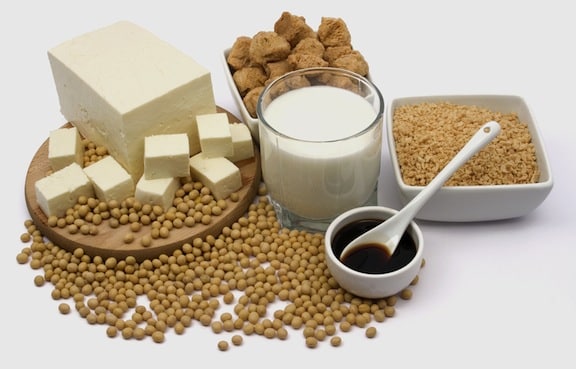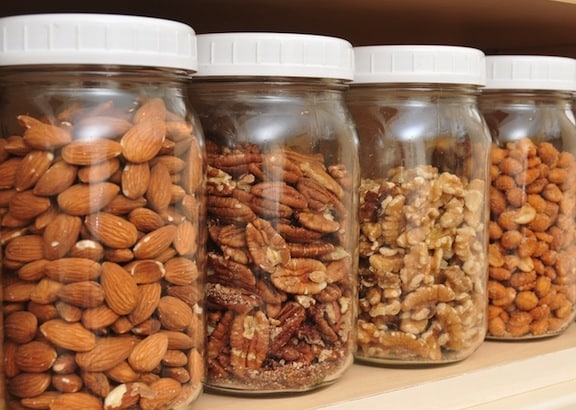Allergies to Soy Can Prevent a Vegetarian Diet
Going vegetarian in college did not exactly bring me the surge in health and vitality that I'd expected. Far from it: my sinuses clogged, thoughts grew fuzzy, skin broke out, and periodically I developed the worst stomach pain ever! After some investigation, I suspected that I had a soy allergy, and if you've made your way to this article, chances are you might suspect the same.
After a few weeks of "trying veg," I would crawl back to my meat-eating ways, ashamed that my body seemed to thrive on chickens, cows and fish. Because I can telepathically communicate with animals, though, the Standard American Diet seemed equally intolerable: I could actually feel the pain, fear and sorrow of each animal I consumed. With the choice to "meet my meat," or suffer the after-effects of another vegetarian stint, I lost all pleasure in food.
Through sheer determination to make a vegetarian diet work for me, I finally isolated the problem: food allergies. By the time I decided to go vegan, I was allergic to soy, nuts, wheat, and some legumes. In fact, a visit to the allergist confirmed that the only foods I was not allergic to were mold and pork. Ewww! OK, most of those I could do without, but soy? How can someone stay vegan without tofu? Especially if they can't fill up on seitan and walnuts!
But a funny thing happened. When I eradicated all hidden sources of dairy for thirty days, many of my reactions lessened. Unfortunately, soy continued to annoy for quite some time, and so I learned to live without it.
How can I tell if I'm allergic to soy?
You can visit an allergist to have a skin or blood test, which will determine a true allergy; however, you can experience sensitivities without having a full-blown soy allergy. Symptoms can include stomach pain, breast tenderness, altered menstrual cycle, acne, slow thyroid, mood changes, excess phlegm, brain fog, and/or joint pain.
If you suspect soy plays a role in your health concerns, completely avoid it for two weeks and then reintroduce it. Pay attention to any reactions. If you have a reaction but really, really hope it's just a coincidence, repeat the experiment again—two weeks off, reintroduce, observe. You might also test different types of soy. For example, some people have trouble with isolated soy protein or chocolate soymilk, but they can eat organic tofu just fine.
People do occasionally outgrow soy allergies, but it can take a year or more of complete avoidance to stop triggering a negative response. Once you determine you have a problem with soy, your quickest route to embracing tempeh probably involves a year of soy-abstinence. Then you can try your experiment again, taking some food enzymes to encourage a happier outcome.
Where will I get my protein?
So many other forms of protein exist that you really don't need soy in order to thrive. If you tolerate gluten, you can enjoy seitan in place of tempeh or tofu. Packed with protein, this "wheat meat" absorbs flavors just like its soy cousins. Legumes and nuts contain large amounts of protein, too. Soaking beans, nuts, seeds and grains activates their enzymes, thereby increasing the protein your body can absorb from them.
If you still feel concerned about getting adequate protein, Rainbow Light and Nutribiotic make rice protein powders, and a variety of sources sell hemp protein powder, which does not cause the bloating associated with whey or soy supplements.
Also consider some of the largest and strongest animals on earth—gorillas, elephants, bison—who eat mostly greens. Choosing amino-acid rich grasses and leaves, they grow huge muscles without soy sausages and protein supplements. You can, too. To get more greens into your diet, start your day with a "green smoothie," made popular in Green for Life by raw food educator Victoria Boutenko. Blend a handful or two of greens with two cups of water and some fruit. You might even throw in some superfoods like spirulina, acai berries or hemp nuts. Green smoothies improve your digestion, sometimes eliminating the strain that caused your original sensitivity.
Where can I find a soy-free veggie burger and soy-free, dairy-free milk?
There are lots of soy-free burgers on the market today! Just read labels. You can also make your own by mixing a grain, some beans or seeds, something gooey like nut butter or oil, fresh herbs, and other seasonings—mashing them all together into a patty.
Same goes for dairy-free milks. There are so many kinds on the market — rice, almond, cashew hemp ...
You can make your own alternative milks. To make almond milk, soak 1 cup raw almonds overnight in the refrigerator. Rinse and add three cups of water. Blend thoroughly and then strain through cheesecloth or a special nut/seed milk bag. Save the pulp for something else and then re-blend the liquid, adding in any flavoring you desire.
Why should I cleanse if I have food allergies?
Allergies of any kind indicate that your body has passed its threshold for effective elimination of toxins. When our liver, colon, lungs and kidneys work well, our skin and immune system don't need to overreact. Ongoing stress, physical or emotional trauma, exposure to pesticides or pollution, medication, and diets rich in animal fat increase our toxic load. Eventually, our organs can't keep up with the demand for detoxification, and things go haywire. Some people develop cancer; others get asthma. Sometimes the body instinctively rejects otherwise healthy foods that require extra processing.
A healthy body digests soy or wheat, but in a compromised state, even health foods can trigger an aggressive immune response. Burdock root and milk thistle provide liver support, while red clover helps the kidneys. Nettles support kidneys and open the bronchia. Green smoothies, psyllium husks and raw foods stimulate and cleanse the colon. You can also try fasting one day per week, in order to give your digestive system a much needed break.
A word about candida
Most people with food allergies, including soy allergy, also suffer from Candida overgrowth. Commonly known as "yeast," Candida naturally lives in our digestive tracts. A "yeast infection" or "thrush" indicates severe overgrowth spreading into other areas of the body.
When the ratio of Candida to "good bacteria" grows too high, this fungus latches onto and tears portions of the intestine, creating a "leaky gut" that allows whole protein molecules to enter the bloodstream. These undigested protein molecules seem like foreign invaders to the immune system, which launches an attack.
Oil of Oregano, Pau d'Arco tea, and acidophilus are three common supplements that combat Candida. (Note: in order to reap the highest benefits, take probiotics like acidophilus a couple hours after Oil of Oregano, and don't try to kill the yeast too fast! Candida produces a severe die-off reaction, so cleansing requires patience.)

Laura Bruno is a Life Coach, Medical Intuitive and Animal Communicator who writes and teaches about natural healing. For more information and articles, please view International Renaissance Coaching.
- For more tips on plant-based nutrition, make sure to browse VegKitchen's Nutrition page.
- For lots more features on healthy lifestyle, please explore VegKitchen's Healthy Vegan Kitchen page.
Allergies to Soy Can Prevent a Vegetarian Diet
Source: https://www.vegkitchen.com/soy-allergy-whats-vegan-vegetarian/
